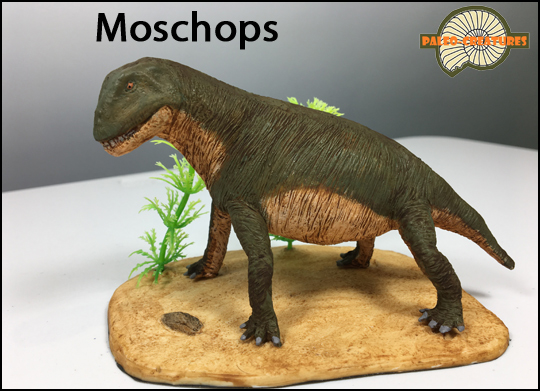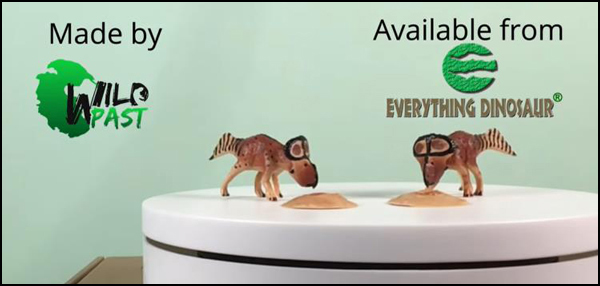Stunning Wild Past Protoceratops Model on Display
The Photogenic Wild Past Protoceratops
Our thanks to model collector Elizabeth who sent into Everything Dinosaur a photograph of her recently acquired Wild Past Protoceratops dinosaur model on display. Enthusiastic collector Elizabeth had combined her Protoceratops andrewsi figure with the base from the Paleo-Creatures Moschops replica. The result is a very effective composition, highlighting the attention to detail that can be found in both these ranges, Wild Past and Paleo-Creatures.
The Wild Past Protoceratops
The Wild Past 1:35 Scale Protoceratops andrewsi Displayed on the Paleo-Creatures Moschops Base
Depicting an Ancient Environment
Elizabeth’s choice of display base for her model is very appropriate. Protoceratops fossil remains are associated with two geological formations, the Djadochta Formation epitomised by the astonishing beauty and desolation of the Flaming Cliffs site, the type locality for this formation, from which the fossil remains of Protoceratops andrewsi have been recovered. Secondly, the larger species Protoceratops hellenikorhinus, is known from the Bayan Mandahu Formation which outcrops some 450 km (280 miles) to the south-east of the Flaming Cliffs location.
Both formations are dominated by sandstones and remarkably, the climate in these areas today is roughly comparable to the palaeo-climate of the Late Cretaceous. Displaying the Wild Past Protoceratops andrewsi on a sandy base is an accurate reconstruction of the habitat of this neoceratopsian.
The biota associated with the Upper Cretaceous deposits of the Djadochta and Bayan Mandahu formations occupied a harsh, arid scrubland with little permanent water. Biologists refer to such difficult habitats as “stressed environments”, the absence of large vertebrates, such as the fossils of much bigger dinosaurs, supports the hypothesis that Protoceratops and the other Late Cretaceous residents had to endure a harsh climate.
The Paleo-Creatures Moschops Model with the Sandy Display Base

Picture credit: Everything Dinosaur
An Exciting Start for a New Model Range
The 1:35 scale Protoceratops is the first in a new range of models (Wild Past), Elizabeth emailed to say:
“Here’s another photo for you to use if you wish. It’s the Wild Past Protoceratops – I think this is such an exciting start to a new line.”
Ironically, both the Wild Past Protoceratops and the Paleo-Creatures Moschops have featured on Everything Dinosaur’s YouTube channel, in a series of short videos we have entitled “turntable Tuesday”.
The Moschops and the Protoceratops andrewsi videos can be found on Everything Dinosaur’s YouTube channel: Everything Dinosaur on YouTube.
The Wild Past Protoceratops Dinosaur Model Showcased by Everything Dinosaur for “Turntable Tuesday”

Picture credit: Everything Dinosaur
Visit the Everything Dinosaur website: Everything Dinosaur.
Commenting upon her photograph, Elizabeth added:
“She [the Protoceratops] is gate-crashing the base of the Paleo-Creatures Moschops. She seems intent on checking out the sizeable footprint of the animal that walked over the sand previously, perhaps while she was away foraging for her minute hatchlings in the nest!”
In our correspondence with the photographer, we highlighted a research paper published back in 2011, that examined an extremely rare event preserved in the fossil record. A footprint of a protoceratopsid dinosaur had been found in association with the fossilised remains of a Protoceratops. As Elizabeth’s photograph depicts a Protoceratops investigating a footprint, it could be argued that is an example of art imitating science.
Link to our blog article about the 2011 protoceratopsid body and trace fossil study: Stopping a Dinosaur Dead in its Tracks.
Our thanks to Elizabeth for sending into Everything Dinosaur such a well-composed photograph.
The Wild Past Protoceratops model can be found here: Wild Past Models.


